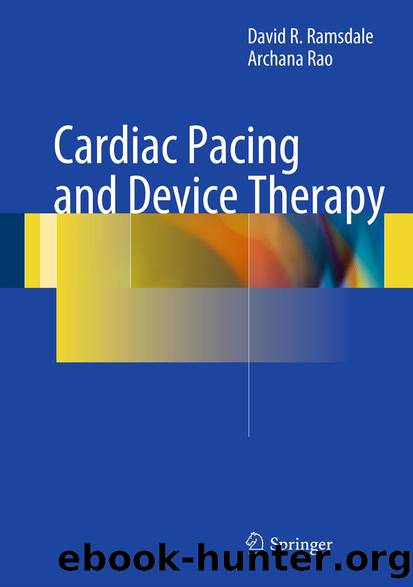Cardiac Pacing and Device Therapy by David R. Ramsdale & Archana Rao

Author:David R. Ramsdale & Archana Rao
Language: eng
Format: epub
Publisher: Springer London, London
Fig. 13.35Landmarks for subclavian vein puncture
When the subclavian vein is entered, venous blood will be easily aspirated from this large vein. The syringe is removed (taking care not to move the needle) and a soft-tipped J-shaped guidewire is then inserted through the needle and into the subclavian vein and advanced through the left brachiocephalic vein into the SVC. The needle is then removed and a sheath within which there is a tapered vessel dilator is passed over the wire into the vein. Care must be taken to ensure that the guidewire always extends outside of the sheath during its insertion in order to avoid losing the guidewire within the venous system. The guidewire and dilator are then removed, leaving the sheath in situ, and the pacing lead is then passed through the sheath along the same route to the SVC and right atrium. Ensuring a head-down position during insertion and blood flow out of the needle and sheath during insertion of the guidewire and pacing lead, respectively, should prevent air embolism from occurring. An alternative approach should be considered if the patient has received thrombolytic therapy, is anticoagulated, or if the contralateral subclavian vein has been used and permanent pacing is likely to be required.
Download
This site does not store any files on its server. We only index and link to content provided by other sites. Please contact the content providers to delete copyright contents if any and email us, we'll remove relevant links or contents immediately.
When Breath Becomes Air by Paul Kalanithi(7263)
Why We Sleep: Unlocking the Power of Sleep and Dreams by Matthew Walker(5641)
Paper Towns by Green John(4169)
The Immortal Life of Henrietta Lacks by Rebecca Skloot(3826)
The Sports Rules Book by Human Kinetics(3588)
Dynamic Alignment Through Imagery by Eric Franklin(3488)
ACSM's Complete Guide to Fitness & Health by ACSM(3468)
Kaplan MCAT Organic Chemistry Review: Created for MCAT 2015 (Kaplan Test Prep) by Kaplan(3423)
Introduction to Kinesiology by Shirl J. Hoffman(3299)
Livewired by David Eagleman(3121)
The River of Consciousness by Oliver Sacks(2992)
Alchemy and Alchemists by C. J. S. Thompson(2911)
The Death of the Heart by Elizabeth Bowen(2901)
Descartes' Error by Antonio Damasio(2731)
Bad Pharma by Ben Goldacre(2729)
Kaplan MCAT Behavioral Sciences Review: Created for MCAT 2015 (Kaplan Test Prep) by Kaplan(2491)
The Gene: An Intimate History by Siddhartha Mukherjee(2491)
The Fate of Rome: Climate, Disease, and the End of an Empire (The Princeton History of the Ancient World) by Kyle Harper(2436)
The Emperor of All Maladies: A Biography of Cancer by Siddhartha Mukherjee(2431)
